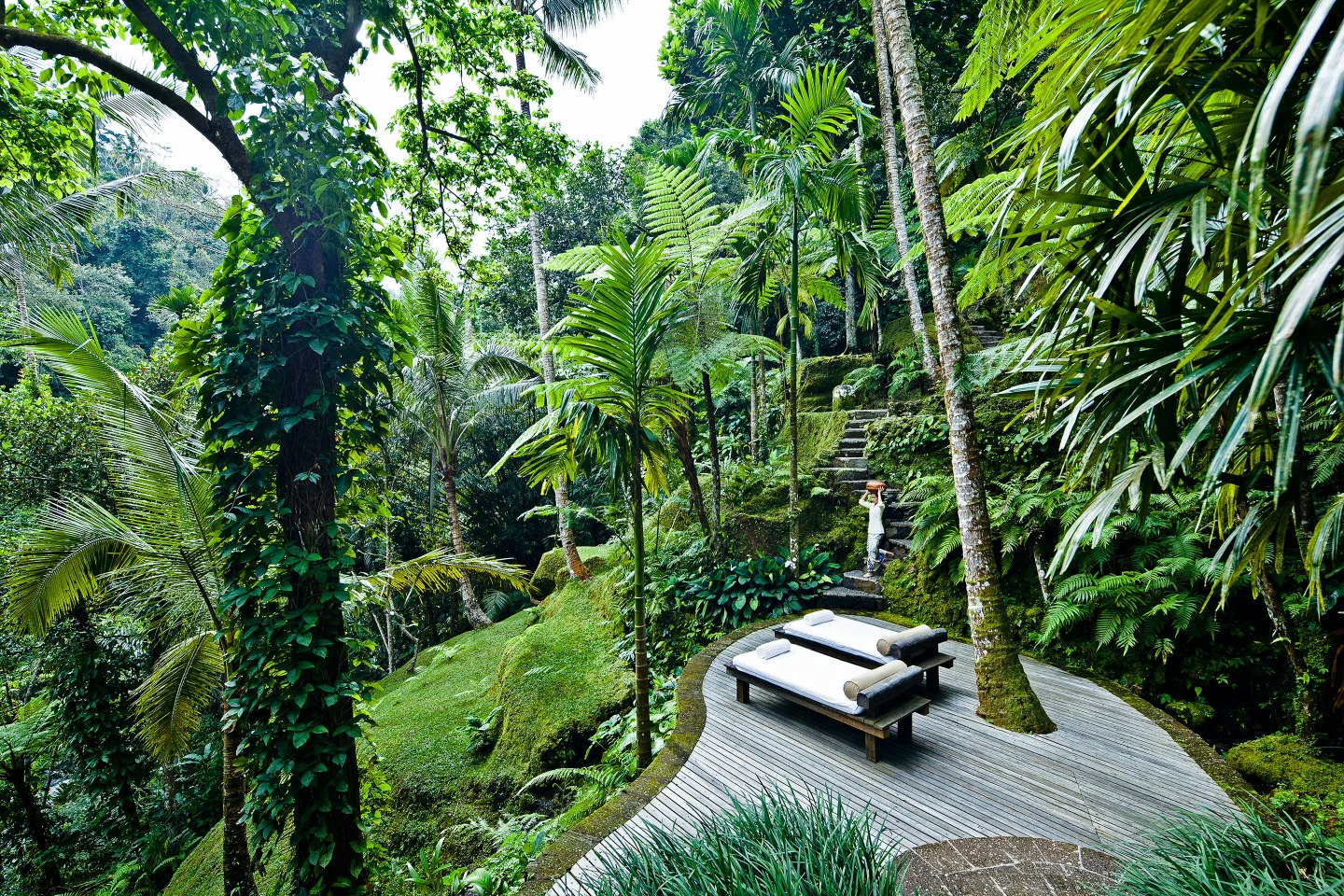Falling water is the prevailing sound at Gunung Kawi Sebatu, one of the most captivating yet least visited temple complexes in Bali. Nestled within a verdant glade seven miles northeast of Ubud, it’s composed of a series of ponds and pools—most full of golden carp sheltered by lotus flowers and water lilies—fed by the natural spring that flows beneath. Roaming guinea fowl and baby deer create a lively contrast to the many grinning statues that preside over the water gardens. Beyond a stone stairwell flanked by a traditional candi bentar, or Balinese gateway, rows of offering baskets brimming with fruit and fuchsia-hued flowers line the foundations of shrines bedecked with dragons and other mythical creatures, blanketing the gray stone in a joyous riot of color.
Sites like this one are commonplace in Bali, a land of revelations spanning the sensory to the spiritual. The 1930s saw the Indonesian island’s first influx of intrepid, high-profile travelers, including Charlie Chaplin, Noël Coward, and Cole Porter. In the ensuing decades, Bali’s uniquely entrancing mix of beauty and hospitality has drawn tourists in ever-increasing numbers from around the world. And while it’s the furthest thing from undiscovered, it’s now drawing a new influx of visitors as the world’s premier destination for holistic healing and wellness travel.
When India’s first Prime Minister, Jawaharlal Nehru, visited Bali in 1954, he famously called it “the morning of the world,” a description that’s especially apt of Ubud, Bali’s beating heart. Perched on the Ayung River, it may be literally the greenest place on earth; dizzyingly dense jungle foliage seems to swathe every inch of town in a boundless thicket of towering palms, ferns, and other flora, while rice paddies shimmer an electric emerald in the tropical sun. This enclave of some 30,000 is Bali’s cultural capital, where the island’s revered artisanship, mysticism, and natural beauty converge.
The creative gifts of Balinese artisans—who excel at painting, carving, and weaving—are a defining element of the island’s magnetism. Their masterful talents are such that there is no word for “artist” in the Balinese language; art is simply second nature, an inherent part of the collective identity. While the Neka Art Museum and the Museum Puri Lukisan offer dazzling overviews of the various schools of island art, it’s worth visiting the studios on the outskirts of Ubud to observe the craftsmen at work. In Mas, a village known for wood carving, you’ll encounter woodworkers hunched over blocks of teak or green hibiscus clenched between their feet, honing the wood into, say, an exuberantly bejeweled Ganesha, the elephant-headed Hindu god of prosperity and new beginnings, emerging from a three-dimensional canopy of impossibly intricate leaves, each whittled almost as thin as paper.

Neither tourist throngs and their attendant traffic jams nor other modern-day aggravations can shatter the palpable grace that permeates the island. This ethereal calm is rooted in rwa bhineda, the Balinese philosophy of balance. Tolerance is another tenet; the Balinese view differences among people as a welcome and requisite component of an even cosmic keel—a generous perspective that especially befits an economy 80% dependent on tourism.
In the seaside hamlet of Canggu, Ubud’s arresting jungle tableaux are replaced by hypnotic coastal ones: Surfboard flotillas slice through foaming breaks in the violet shadows of village temples built on massive rocks jutting into the sea. Its volcanic black sands, thundering swells, and ocean breezes scented by frangipani have long lured surfers from far and wide to create a vibrant expat community. Though hardly under the radar, this laid-back village on the island’s southern shore remains charmingly devoid of the tourist sprawl found in nearby towns such as Kuta and Seminyak.
Not that Canggu is escaping Bali’s luxury boom. Its beachside bars, teeming with tattooed denizens swigging beers, are gaining new, more upscale neighbors. Luxury villas are multiplying fast, as are real estate prices. Top-shelf eateries helmed by accomplished expat chefs, as well as a slew of chic new boutiques and quirky coffeehouses, are cropping up alongside Bali’s traditional roadside cafés—meaning discerning travelers, lured by Bali’s inimitable magic, are surely soon to follow.
Where to Stay
In Ubud:

Four Seasons Bali at Sayan
Situated among the treetops of the Ayung River valley, the resort is a singular study in jungle luxury located just minutes away from downtown Ubud. With its unique rice-bowl-shaped architecture and stunning riverside villas, it’s an especially striking standout in the Four Seasons portfolio.

COMO Shambhala Estate
The jewel in the crown of the COMO Hotels and Resorts collection, this sprawling resort, set on 23 jungle acres just outside Ubud, is one of the world’s most acclaimed wellness destinations. Guests can visit traditional healers or bathe in the forest’s natural spring pools.
In Canggu:

COMO Uma Canggu
Located on Echo Beach, this resort’s centerpiece beach club, from Italian design superstar Paola Navone, serves up scrumptious cuisine and staggering sunsets in a colorful surf-shack setting.
A version of this article appears in the May 2019 issue of Coins2Day with the headline “Bali’s Inimitable Allure.”
